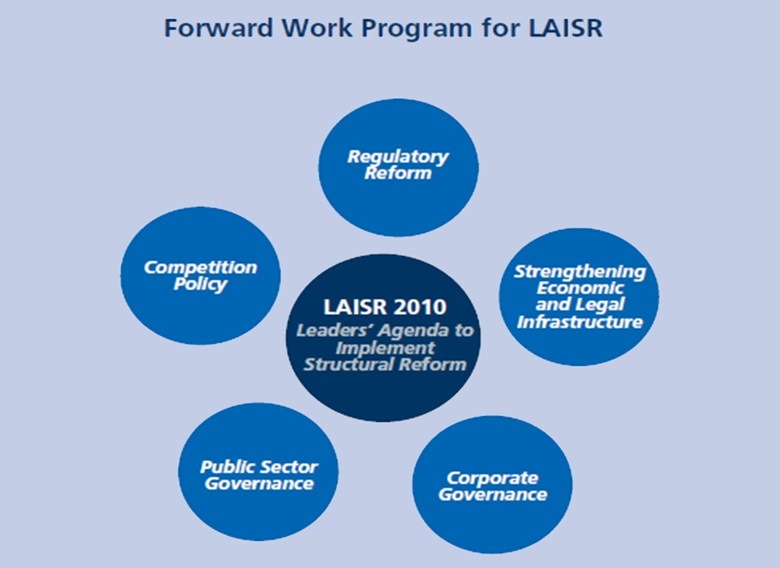Structural reform: Appreciating gains with eyes on the future

When APEC Leaders meet in Yokohama they will have the opportunity to review achievements and set the future direction for a significant multi-faceted program intended to drive balanced regional economic growth through structural reform.
Launched by Leaders in Santiago, Chile, in 2004, the current Leaders' Agenda to Implement Structural Reform (LAISR) has been scheduled to conclude at the end of 2010 with a stocktake of structural reforms. At their 2009 meeting in Singapore, Leaders expressed a desire to "reenergise APEC's work on structural reform" and directed ministers and officials to strategise the next phase of the LAISR.
The importance of this program was made clear by the Leaders of APEC member economies in their 2009 declaration.
"Structural reform will be critical to strengthening long-term potential output growth and narrowing the development gap between economies, by improving economic flexibility, fostering private demand, and developing financial markets," Leaders noted before going on to highlight APEC's unique capabilities to lead such reforms.
"We will leverage APEC's traditional strengths of voluntary cooperation, capacity building, sharing of best practices, and working with the private sector, to implement necessary reforms in infrastructure development, agriculture/food management, social security, education and workforce training, and regulatory frameworks."
Following this directive, APEC Economic Committee Chair, Dr. Takashi Omori, said the Economic Committee has been working on policy options for Leaders to consider in the next stage of the APEC structural reform process.
"It has been proposed that APEC's activities around structural reform should now be expanded to cover sector-specific topics, such as the labor market or social safety nets," Dr. Omori said in the lead-up to the 2010 APEC Leaders' Meeting.
To achieve its objectives, the LAISR initiative, set five priority areas intended to stimulate policy-oriented discussions on structural reform linking in to most facets of APEC's broader agenda. These five components are regulatory reform, competition policy, corporate governance, public sector governance and strengthening economic and legal infrastructure.
Dr. Omori welcomed LAISR achievements of recent years in the five priority areas.
"Progress has been made in each of these areas, and in every economy within APEC, with the knowledge that sustainable growth comes from higher productivity," said Dr. Omori.
In preparation for AELM, the APEC Economic Committee has been working on re-formulating these themes and develop policy options that reflect current structural reform priorities and provide an updated framework for future progress.
Research and analysis by the Economic Committee, senior officials and ministers has considered the value of regulatory reforms in areas such as competition policy and public sector governance continuing along their current trajectories and building on current achievements. Further policy discussion that has been undertaken by the Economic Committee has included considering issues such as expanding the structural reform agenda to include greater focus on areas such as corporate law and governance together with further engagement in the "Ease of Doing Business" action plan.
APEC fora and working groups have been active in meeting the objectives of the LAISR initiative in preparation for AELM, engaging in numerous training workshops and government education programs have been undertaken in member economies to equip government officers with skills required to work more efficiently with business in areas such as e-trade and customs clearance using a single-window system.
Separate APEC initiatives have included the training of personnel from government agencies so that they can better understand and counter the activities of criminals involved in corruption and money laundering. Other projects have engaged government departments to better identify chokepoints in global trade supply lines.
Dr. Omori said this high productivity "requires sound incentives and a competitive business environment for all, including smaller enterprises."
Recognising that APEC's approach to structural reform needs to take into account individual economies' stage of development, demographic trends, factor and institutional endowments, and comparative advantages, Leaders also highlight the importance of working with other international organisations including international financial institutions and multilateral development banks.
The value of this approach to other international bodies was highlighted by Professor Peter Drysdale, from the Crawford School of Economics and Government at the Australian National University, in his keynote address to the APEC Economic Committee Roundtable in Beppu, Japan, this year.
"Structural reform is now a high priority in Asia and the Pacific and is seen as an area in which Asia can contribute to the international agenda through the G20 process," Professor Drysdale said at the roundtable noting the G20 Meeting due to take place in Seoul immediately prior to the APEC Leaders' Meeting.
"It can contribute not only via broadening the agenda out to a wider group of economies but also by deploying its proven, consensus-based processes and its use of capacity building to drive implementation of reforms with real economic impact at the sectoral level.
"APEC has a very impressive record of achievement in innovative and effective international economic diplomacy, and in helping to secure the economic and political foundations for spectacular regional growth, the scale of which the world has never seen before."

